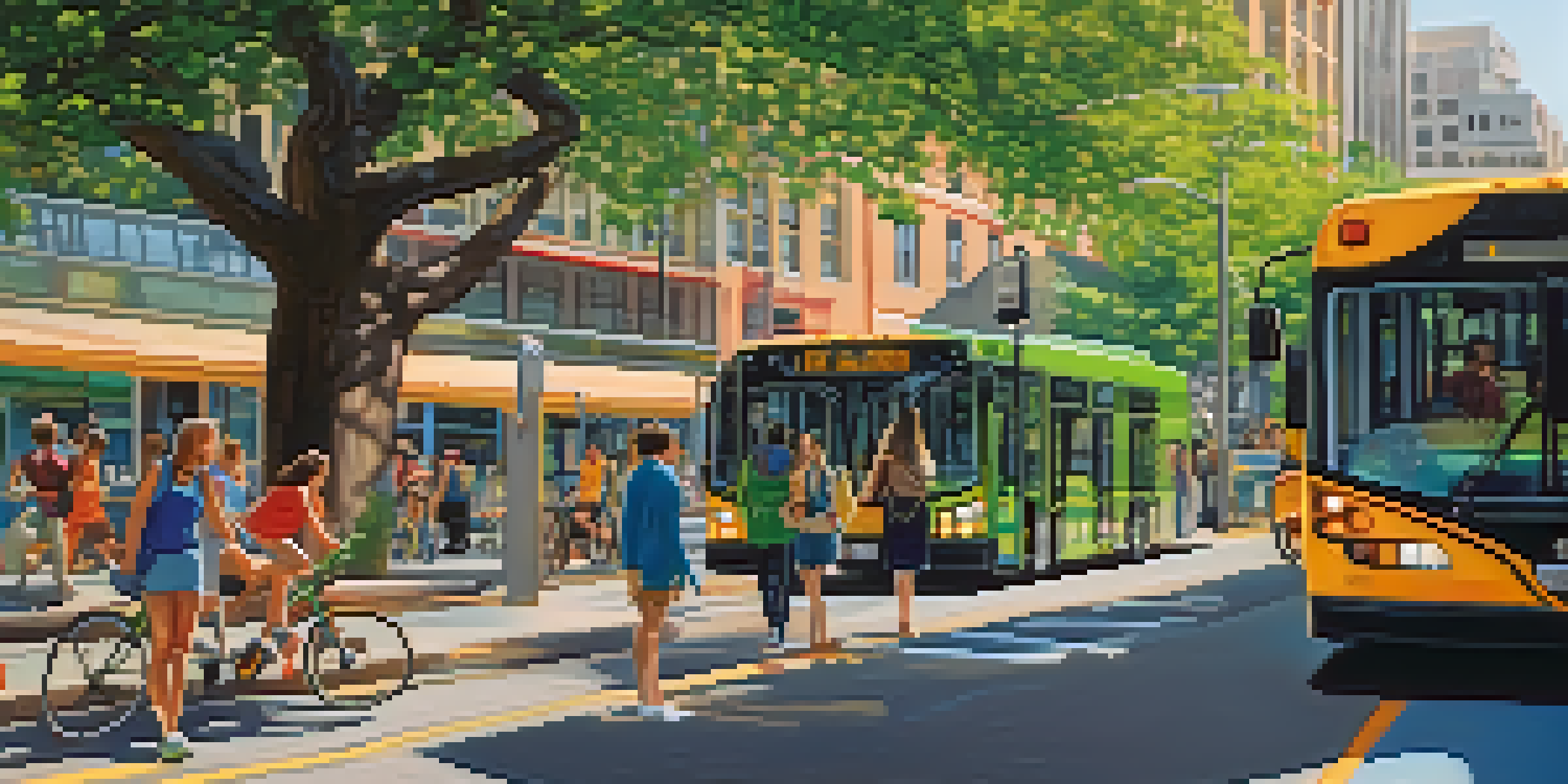Sustainability and Public Transit: Austin's Green Initiatives

Austin's Commitment to Sustainability in Transit
Austin has made significant strides in enhancing the sustainability of its public transit system. The city recognizes that a robust public transit network not only reduces traffic congestion but also lowers greenhouse gas emissions. With initiatives that prioritize eco-friendly practices, Austin is setting an example for other cities aiming for greener solutions.
Sustainability is no longer about doing less harm. It's about doing more good.
One of the core elements of Austin's sustainability efforts is the integration of electric buses into the Capital Metro fleet. These electric buses help decrease reliance on fossil fuels and contribute to cleaner air in the city. By investing in electric vehicles, Austin is showing its commitment to innovation and environmental responsibility.
Moreover, the city is actively working to improve public transit accessibility, ensuring that everyone can benefit from these green initiatives. By expanding service areas and increasing frequency, Austin aims to make public transportation a more attractive option for all residents, encouraging a shift away from personal vehicles.
Innovative Transportation Solutions in Austin
Austin is not just about buses; it's exploring a variety of innovative transportation solutions to promote sustainability. For instance, the city has embraced bike-sharing programs and electric scooters as part of its transit ecosystem. These options provide residents with environmentally friendly alternatives for short trips, reducing the overall carbon footprint.

The implementation of dedicated bike lanes and pedestrian-friendly pathways has also been a focus for the city. This infrastructure encourages more people to choose biking or walking over driving, which contributes to less traffic congestion and lower emissions. It's a win-win for both the environment and public health.
Austin's Electric Bus Initiative
Austin is integrating electric buses into its transit system, reducing fossil fuel dependence and improving air quality.
In addition, ride-sharing partnerships have emerged as an effective way to complement public transit. By making it easier to use multiple forms of transportation, Austin enhances the overall efficiency of its transit system while promoting sustainable practices.
Community Engagement in Sustainable Transit
Community involvement plays a crucial role in Austin's green transit initiatives. The city frequently conducts public forums and surveys to gather input from residents on transit needs and preferences. This engagement ensures that the green initiatives align with the community's desires and fosters a sense of ownership among residents.
The best way to predict the future is to create it.
Furthermore, educational campaigns are launched to inform the public about the benefits of sustainable transit options. These campaigns help to raise awareness about the environmental impact of personal vehicle use and the advantages of public transportation. By communicating these messages effectively, Austin encourages more residents to make eco-conscious choices.
Additionally, partnerships with local organizations and businesses promote sustainability initiatives. Collaborative events, such as car-free days or bike-to-work challenges, not only engage the community but also create a culture of sustainability that extends beyond just public transit.
Funding Sustainable Transit Initiatives
Funding is a critical aspect of implementing sustainable transit initiatives, and Austin has been proactive in securing resources. The city has leveraged federal grants and state funding to support the development of its electric bus fleet and infrastructure. These financial resources are vital for making long-term investments in green transit solutions.
Moreover, local initiatives like the Mobility Bond have enabled the city to allocate funds specifically for enhancing public transit systems. This bond reflects the community's commitment to improving transportation options while prioritizing environmental sustainability. It's a clear indicator that residents value green initiatives.
Community Engagement is Key
The city actively involves residents in shaping transit solutions through public forums and educational campaigns.
Additionally, partnerships with private companies can provide further financial support. Collaborations with tech firms focusing on transportation innovations can create new funding avenues and bring cutting-edge technology into Austin's transit system.
Challenges Facing Sustainable Public Transit
Despite its ambitious green initiatives, Austin faces challenges in creating a fully sustainable public transit system. One significant hurdle is the city's rapid growth, which can strain existing transit resources. As more people move to the area, the demand for expanded services and infrastructure increases, making it essential to stay ahead of the curve.
Another challenge is the need for public buy-in. While many residents appreciate the benefits of sustainable transit, others may be resistant to change, preferring the convenience of personal vehicles. Addressing these concerns through effective communication and community engagement is vital for fostering a supportive environment.
Lastly, funding limitations can hinder progress. While Austin has made strides in securing financial resources, the ongoing need for investment in infrastructure and technology requires continuous effort and innovative solutions.
The Future of Public Transit in Austin
Looking ahead, the future of public transit in Austin appears promising, especially with the city's ongoing commitment to sustainability. Plans are in place to expand electric bus routes and further develop the bike-sharing program. These initiatives aim to create a seamless, eco-friendly transportation network that caters to the needs of a growing population.
Furthermore, as technology advances, Austin is exploring smart transit solutions. This includes implementing real-time tracking systems for buses and integrating apps that help users plan multi-modal trips efficiently. By leveraging technology, the city can enhance user experience and make sustainable transit more appealing.
Sustainable Transit Faces Challenges
Austin's rapid growth and funding limitations pose significant challenges to fully realizing its sustainable transit goals.
Ultimately, Austin's vision of a greener public transit system serves as an inspiration for other cities. By prioritizing sustainability, community involvement, and innovative technologies, Austin is paving the way for a brighter, more eco-friendly future.
Conclusion: The Impact of Sustainable Transit
Austin's green initiatives in public transit are not just about reducing emissions; they represent a holistic approach to urban living. By creating a comprehensive, sustainable transit system, the city is fostering a healthier environment and promoting social equity. Everyone deserves access to reliable and eco-friendly transportation.
Moreover, these initiatives have the potential to transform the city's culture around mobility. As more residents embrace public transport and alternative modes of travel, Austin can reduce its traffic woes and improve air quality. This cultural shift can lead to a more vibrant, connected community.

In conclusion, Austin's commitment to sustainability in public transit exemplifies how urban areas can adapt to modern challenges. By prioritizing green initiatives, the city not only enhances the quality of life for its residents but also sets a standard for sustainable urban development.